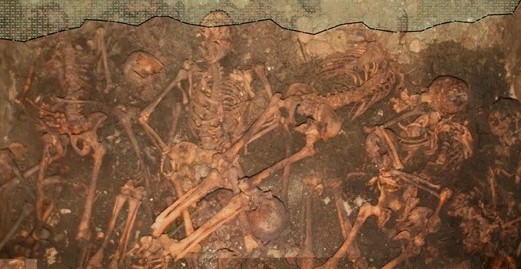
New chemical analyzes: What did Danes and Italians in the Middle Ages have in common?
Chemists have analyzed bones from a Danish and an Italian cemetery, casting light on the lives of nobles and common people in the north and the south of Europe.
In the 1600s, two private chapels were erected as family burial sites for two noble families. One in the town Svendborg in Denmark, the other in Montella, Italy. They were both attached to a Franciscan Friary, and only a few meters from the chapels, more common townspeople and friars were buried in the cloister walks.
Now scientists have had access to the earthly remains of both the noble families and the less fortunate in Svendborg and Montella, and this gives an intriguing insight into what these people consumed while they were alive.
- We expected to find common features for the two different social classes, and we did so - in part. But we also found similarities and differences that are not linked to social status, says professor of archaeometry, Kaare Lund Rasmussen, University of Southern Denmark.

The Montella Chapel near Naples, southern Italy, was built in the 1620s when Giovanni Bernardino Iannelli donated a large sum to the monastery. It has been excavated since 2007.
The researchers looked for a number of specific trace elements and heavy metals in the bone samples: Strontium, barium, lead, copper and mercury.
Common to these elements is that their presence in bones reveal information about a person's diet and what that person’s mouth has been in touch with during his or her life.
Less strontium and barium were found in the bones from the noble chapels compared to the bones from the cloister walks.
These two trace elements are most often ingested through food, and the low levels in the nobles indicate that they ate more animal meat. This makes good sense, because meat in both Italy and Denmark was a more expensive than for example cereals and porridge.

The Hardenberg chapel in Svendborg was probably erected by the noblewoman Helvig Hardenberg in the late 16th century. When the railroad came to town in 1876, it was demolished.
The copper content in the Danish bones is significantly lower than in the Italian - both in those from the chapels and the cloister walks.
- This can be explained by the fact that the Danes did not prepare food in copper pots and vessels - and conversely, that the Italians did it diligently, regardless of their social status, Kaare Lund Rasmussen comments.
When cooking or storing food in copper pots, knives and spoons may scrape off small amounts of copper, which are then consumed with the food, and thus the body can accumulate copper over time. The copper level was 21 times higher in the Italians than in the Danes.
Lead poisoning of the rich
Both the Danish and Italian noble families had more lead in the bones than the less wealthy - the Danes slightly more than the Italians.
- High lead concentrations indicate high social status. We have also seen that from other studies, says Kaare Lund Rasmussen.
Lead had many uses in the Middle Ages, and especially the wealthy could afford it: It was used to glaze earthenware: kitchen utensils could consist of pure lead; lead salts were added to wine to inhibit fermentation, and lead sheets were used as roofing with the result that collected rainwater came to contain some lead.
Kaare Lund Rasmussen has previously shown that the ancient Romans and wealthy Germans and Danes in the Middle Ages could be more or less permanently sick with lead poisoning from consuming too much food and drink that had been in contact with lead.
Equal access to mercury medicine in Denmark
Mercury was a widespread remedy for diseases such as leprosy and syphilis in the Middle Ages. The analyzes show that at least a handful of the noble Italian Iannelli family members ingested mercury in their lifetime. None of the skeletons from the Italian cloister walk contained mercury.
In Denmark, the distribution of mercury was more equal.
- It seems that both social groups in Denmark had equal access to mercury containing medicine. However, none of them exhibited particularly high levels.
About the study
The researchers took 87 samples, mainly from femoral bones from 69 individuals. 17 from the chapel and 34 from the cloister walk in Montella. 7 from the chapel and 14 from the cloister walk in Svendborg.
The chemical analyzes are described in a scientific article published in the journal Heritage Science.
Kaare Lund Rasmussen is lead researcher of the study, which was conducted in collaboration with colleagues Paolo d´Imporzano from the Vrije Universiteit in the Netherlands and Thomas Delbey and Lilian Skytte from the Department of Physics, Chemistry and Pharmacy, SDU. From Italy, Marielva Torino of the University of Suor Orsola Benincasa and Simone Schiavone of the Pontifical Institute of Christian Archeology, have contributed with anthropological and archaeological perspectives.
Contact
Kaare Lund Rasmussen is professor of chemistry and a specialist in archaeometry: using scientific techniques to analyze cultural heritage objects. He has previously analyzed the beard of Renaissance astronomer Tycho Brahe, the Dead Sea Scrolls and various sacred relics.